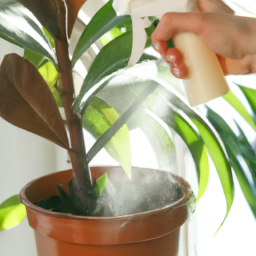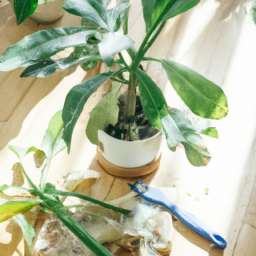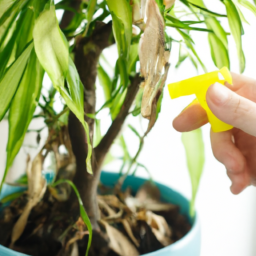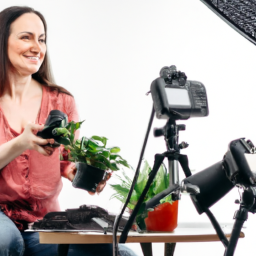
Are you feeling frustrated with your struggling indoor plants? Don’t worry, we’ve got you covered with some helpful tips for reviving those wilted leaves and drooping stems. Whether you’re a seasoned plant parent or just starting out, it’s common to encounter a few bumps on the road to keeping your indoor greenery thriving. In this blog post, we’ll share some simple yet effective techniques to breathe new life into your struggling indoor plants. So, grab your watering can and let’s get started on transforming your sad plants into vibrant, lush beauties once again.
Tips for Reviving Struggling Indoor Plants
Identifying Common Signs of Struggling Indoor Plants
Indoor plants bring life and beauty to our homes, but sometimes they can face challenges that leave them struggling to thrive. As an expert in plant care, I’m here to guide you through the process of reviving your struggling indoor plants. Before we dive into the tips, let’s start by identifying some common signs that indicate your plants are in distress.
Wilting Leaves
One of the most noticeable signs of a struggling indoor plant is wilting leaves. When a plant lacks water or nutrients, its leaves may start to droop and lose their vibrant color. Wilting can also be caused by overwatering, which leads to root rot. It’s important to pay attention to the moisture level in the soil to determine the cause of wilting leaves.
If the soil feels dry, it’s likely that your plant needs more water. On the other hand, if the soil is consistently wet and the leaves are yellowing or turning brown, you may be overwatering your plant. Adjusting your watering routine accordingly can help revive your struggling indoor plant.
In some cases, wilting leaves can also be a sign of inadequate light. If your plant is not receiving enough sunlight, it may not be able to photosynthesize properly, leading to weakened growth and wilting leaves. Moving your plant to a brighter location can make a significant difference.
Yellowing or Browning Leaves
Yellowing or browning leaves are another common sign of a struggling indoor plant. This can be caused by various factors, including nutrient deficiencies, overwatering, or pests. By examining the condition of the leaves, you can gain valuable insights into the underlying issue.
If your plant’s leaves are yellowing uniformly, it may be lacking essential nutrients like nitrogen, iron, or magnesium. Providing a balanced fertilizer specifically formulated for indoor plants can help replenish these nutrients and restore the plant’s health.
On the other hand, if you notice brown spots or edges on the leaves, it could be a sign of overwatering or fungal diseases. Adjusting your watering routine and ensuring proper drainage can prevent further damage and promote recovery.
Pests, such as spider mites or aphids, can also cause yellowing or browning leaves. Inspect your plant closely for any signs of infestation, such as tiny webs or small insects. Treating the pests with organic insecticides or using natural methods like neem oil can help eliminate the problem and revive your struggling indoor plant.
Stunted Growth
If your indoor plant is not showing signs of new growth or its growth seems stunted, it’s a clear indication that something is amiss. Stunted growth can be caused by a variety of factors, including insufficient light, improper watering, or root-bound conditions.
Insufficient light is a common issue for indoor plants, especially those placed in areas with limited natural light. Plants need an adequate amount of light to carry out photosynthesis and sustain healthy growth. Consider moving your plant to a brighter spot or supplementing with artificial grow lights to stimulate growth.
Improper watering, both overwatering and underwatering, can hinder a plant’s growth. It’s crucial to find the right balance by checking the moisture level in the soil regularly. Adjust your watering schedule accordingly to ensure your struggling indoor plant receives the right amount of water.
Root-bound conditions occur when a plant’s roots outgrow its container, leading to restricted growth and nutrient absorption. If you notice roots circling around the edges of the pot or emerging from the drainage holes, it’s time to repot your plant into a larger container. This will provide the roots with more space to grow and promote healthier overall growth.
Conclusion
Identifying the signs of a struggling indoor plant is the first step towards reviving its health. By paying attention to wilting leaves, yellowing or browning leaves, and stunted growth, you can determine the underlying issues and take appropriate action. Remember to adjust your watering routine, provide adequate light, and address any nutrient deficiencies or pest infestations. With proper care and attention, your struggling indoor plants can bounce back and thrive once again, adding beauty and freshness to your home.

Essential Tips for Reviving Indoor Plants with Drooping Leaves
Indoor plants are a beautiful addition to any home or office space. They not only provide aesthetic value but also purify the air and create a calming environment. However, sometimes our beloved indoor plants can start to struggle, with their leaves drooping and losing their vibrancy. If you find yourself in this situation, don’t worry! With a little care and attention, you can revive your struggling indoor plants and bring them back to life. Here are some essential tips to help you get started:
1. Assess the Watering Routine
One of the most common reasons for indoor plants to have drooping leaves is improper watering. It’s crucial to understand the specific watering needs of each plant species. Overwatering can lead to root rot, while underwatering can cause dehydration and wilting. To assess your watering routine, start by checking the moisture level of the soil. Stick your finger about an inch deep into the soil; if it feels dry, it’s time to water the plant. If it feels wet, hold off on watering for a few days. Remember, it’s better to underwater than overwater, as most indoor plants prefer slightly dry conditions.
When watering, ensure that the water reaches the root zone. Avoid pouring water directly onto the leaves, as this can lead to fungal diseases. Use room temperature water and water the plants thoroughly until it drains out from the bottom of the pot. Discard any excess water to prevent waterlogging.
Additionally, consider the humidity levels in your home. Some indoor plants, such as ferns and orchids, thrive in high humidity environments. To increase humidity, you can place a tray filled with water near the plants or use a humidifier.
2. Check for Adequate Lighting
Insufficient or excessive lighting can also contribute to drooping leaves in indoor plants. Different plant species have varying light requirements, so it’s important to identify the ideal lighting conditions for your struggling plant. Most indoor plants thrive in bright, indirect light. Place them near a window where they can receive filtered sunlight throughout the day. Avoid exposing them to direct sunlight, especially during the hottest hours, as it can scorch the leaves.
If your indoor plant isn’t receiving enough light, you might notice elongated stems and pale leaves. In this case, consider using artificial grow lights to supplement natural light. LED grow lights are energy-efficient and provide the necessary light spectrum for plant growth. Position the lights about 12 inches above the plants and keep them on for 12-14 hours a day, replicating the natural daylight cycle.
On the other hand, if your plant is exposed to excessive light, it may show signs of sunburn, such as brown spots or scorched leaves. Move the plant to a slightly shadier location, or use sheer curtains or blinds to filter the light.
3. Evaluate the Temperature and Air Circulation
Temperature and air circulation play a crucial role in the overall health of indoor plants. Most indoor plants prefer temperatures between 60-75°F (15-24°C) during the day and slightly cooler temperatures at night. Avoid placing your plants near drafty windows, heating vents, or air conditioning units, as sudden temperature fluctuations can stress the plants and cause drooping leaves.
Proper air circulation is also important for indoor plants. Stagnant air can lead to the buildup of pests and diseases. Ensure there is adequate ventilation in the room where your struggling plant is located. You can use a small fan on low speed to improve air circulation, but make sure it doesn’t directly blow on the plant.
Furthermore, keep your indoor plants away from any sources of ethylene gas, such as ripening fruits or cigarette smoke. Ethylene can cause leaf drop and premature aging of the plants.
By carefully evaluating and adjusting the temperature and air circulation, you can create a favorable environment for your struggling indoor plants to recover.
In conclusion, reviving struggling indoor plants with drooping leaves requires a systematic approach. Assessing the watering routine, providing adequate lighting, and evaluating the temperature and air circulation are essential steps in the revival process. Remember, each plant is unique, so it’s important to research and understand the specific needs of your indoor plants. With patience, care, and these essential tips, you can bring your struggling indoor plants back to life and enjoy their beauty and benefits for years to come.

body {
font-family: Arial, sans-serif;
line-height: 1.5;
margin: 50px;
}
h2 {
font-size: 24px;
font-weight: bold;
margin-bottom: 20px;
}
h3 {
font-size: 20px;
font-weight: bold;
margin-bottom: 15px;
}
p {
margin-bottom: 15px;
}
Tips for Reviving Struggling Indoor Plants
Effective Strategies for Restoring Health to Overwatered Indoor Plants
Indoor plants can bring life and beauty to any space, but sometimes they can struggle to thrive due to overwatering. If you’ve noticed your indoor plants looking wilted, yellowing, or even experiencing root rot, don’t worry! With some effective strategies, you can revive your overwatered plants and restore their health. In this article, we will guide you through the step-by-step process of reviving struggling indoor plants.
1. Assess the Damage
The first step in reviving overwatered indoor plants is to assess the damage. Look closely at the plant’s leaves, stems, and roots to determine the extent of the problem. Overwatering can lead to root rot, which is characterized by mushy, discolored roots. Wilting and yellowing leaves are also common signs of overwatering. By understanding the damage, you can tailor your revival strategies accordingly.
If the roots are severely affected by root rot, you may need to consider repotting the plant in fresh, well-draining soil. However, if the damage is minimal, you can focus on adjusting your watering routine and providing the necessary care to restore the plant’s health.
2. Adjust Your Watering Routine
One of the most crucial steps in reviving overwatered indoor plants is to adjust your watering routine. Overwatering is often caused by excessive watering or infrequent drainage. To rectify this, follow these guidelines:
– Check the moisture level of the soil before watering. Stick your finger about an inch into the soil; if it feels dry, it’s time to water. If it’s still moist, hold off on watering for a few more days.
– Ensure proper drainage by using pots with drainage holes. If your plant is in a pot without drainage, consider repotting it into a container with adequate drainage to prevent waterlogging.
– Water deeply but infrequently. Instead of lightly misting the plant every day, give it a thorough watering once the soil is dry. This allows the roots to absorb water properly without being constantly soaked.
3. Prune and Propagate
Pruning is another essential step in reviving overwatered indoor plants. Trim away any yellowing or dead leaves, as they are unlikely to recover. This will redirect the plant’s energy towards new growth.
If your plant has severely damaged stems or branches, consider pruning them back to healthy growth points. This will encourage new growth and help the plant recover faster. Remember to use clean, sharp pruning shears to prevent further damage.
Additionally, you can take this opportunity to propagate your struggling plant. Cut healthy stems just below a node and place them in a glass of water or a well-draining potting mix. With proper care, these cuttings will develop roots and grow into new plants, ensuring the survival of your favorite indoor greenery.
4. Provide Adequate Light and Humidity
Light and humidity play crucial roles in the revival of struggling indoor plants. Most indoor plants require bright, indirect light to thrive. Place your plant near a window where it can receive sufficient sunlight without being exposed to direct rays, which can scorch the leaves.
If your plant is not receiving enough natural light, consider using artificial grow lights. These lights mimic the spectrum of natural sunlight and can help your plant regain its strength and vitality.
In addition to light, maintaining proper humidity levels is important. Overwatering often leads to increased humidity, which can create a favorable environment for fungal diseases. To prevent this, ensure adequate air circulation around your plant and avoid misting the leaves excessively.
5. Monitor and Adjust
Reviving a struggling indoor plant is an ongoing process that requires monitoring and adjustments. Keep a close eye on your plant’s progress and make necessary changes to your care routine.
If you notice any signs of stress or overwatering recurring, such as wilting or yellowing leaves, adjust your watering schedule accordingly. Remember, each plant has different needs, so it’s important to observe and learn from your plant’s response to your care.
By following these effective strategies, you can successfully revive your overwatered indoor plants and restore them to their former health and beauty. Remember to be patient and consistent with your care, and soon enough, you’ll see your plants thriving once again.
Let’s wrap up what we learned
If you’ve ever found yourself staring at a sad, wilting indoor plant, you’re not alone. Keeping indoor plants thriving can be challenging, especially when they start to struggle. But fear not! With a little know-how and some tender loving care, you can revive those struggling indoor plants and bring them back to life.
First and foremost, it’s crucial to identify the cause of your plant’s decline. Is it getting too much or too little light? Are you overwatering or underwatering it? Once you’ve pinpointed the issue, you can take the necessary steps to rectify it. For instance, if your plant is receiving too much sunlight, consider moving it to a spot with indirect light. On the other hand, if it’s not getting enough light, you might want to invest in a grow light to supplement its needs. Similarly, adjusting your watering routine according to your plant’s specific requirements can make a world of difference. Remember, each plant is unique, and finding the right balance for yours is key.
Next, don’t shy away from giving your struggling plant a little extra attention. Pruning away any dead or yellowing leaves can help redirect the plant’s energy towards new growth. Additionally, consider fertilizing it with a balanced, water-soluble fertilizer to replenish any nutrients it may be lacking. Lastly, be patient! Reviving a struggling indoor plant takes time, and it won’t bounce back overnight. Keep monitoring its progress, adjust your care routine as needed, and soon enough, you’ll see your plant thriving once again.
In conclusion, reviving struggling indoor plants is a task that requires a bit of detective work, some adjustments to their environment, and a dash of extra care. By identifying the underlying issues, providing adequate light and water, and giving your plant a little extra TLC, you’ll be well on your way to bringing it back to life. So don’t give up on your wilting plant just yet – put these tips into action and watch it flourish once more.
Frequently Asked Questions (FAQ):
Q1: Why are my indoor plants struggling?
A1: There could be several reasons why your indoor plants are struggling. It’s important to consider factors such as inadequate light, improper watering, pests, or disease. Assessing these factors will help you determine the cause and provide the necessary care.
Q2: How can I tell if my indoor plant needs reviving?
A2: There are a few signs that indicate your indoor plant needs reviving. Look for wilting or drooping leaves, yellowing or browning foliage, stunted growth, or a generally lackluster appearance. These signs often suggest that the plant is not receiving adequate care and attention.
Q3: What are some tips for reviving struggling indoor plants?
A3: To revive struggling indoor plants, start by assessing their needs. Ensure they are placed in an appropriate location with adequate light. Adjust your watering routine, making sure not to over or underwater. Check for pests and diseases, treating them accordingly. Prune any dead or damaged foliage and consider repotting if necessary.
Q4: How can I provide adequate light for my indoor plants?
A4: Providing adequate light for indoor plants is crucial for their survival. Place them near a window where they can receive bright, indirect sunlight. If your home lacks natural light, consider using artificial grow lights specifically designed for plants. Ensure the light source is positioned at an appropriate distance to prevent burning or drying out the foliage.
Q5: What should I do if my indoor plant is infested with pests?
A5: If your indoor plant is infested with pests, it’s essential to take prompt action. Start by isolating the affected plant to prevent the infestation from spreading. Identify the pests and choose an appropriate treatment method, such as using insecticidal soap or neem oil. Regularly monitor the plant and repeat treatments if necessary until the infestation is under control.

Lisa Chen is a seasoned indoor gardening expert and the author of several bestselling books on the topic. With a background in horticulture and urban farming, Lisa is dedicated to helping urban dwellers embrace the joys of cultivating green spaces indoors. Her detailed guides and hands-on tips empower readers to transform their living spaces into thriving plant sanctuaries.


